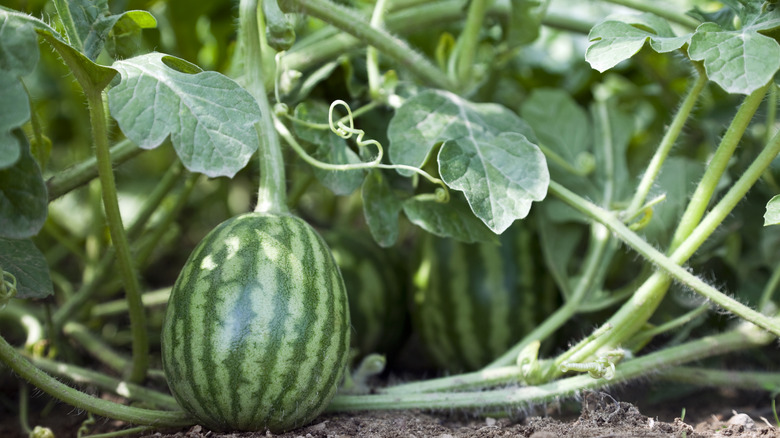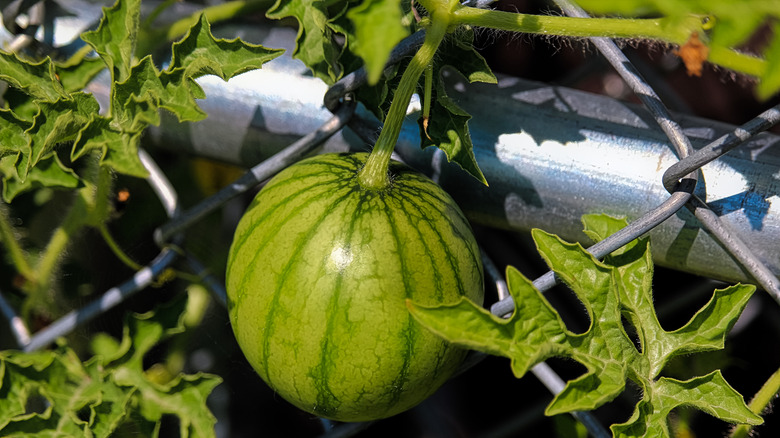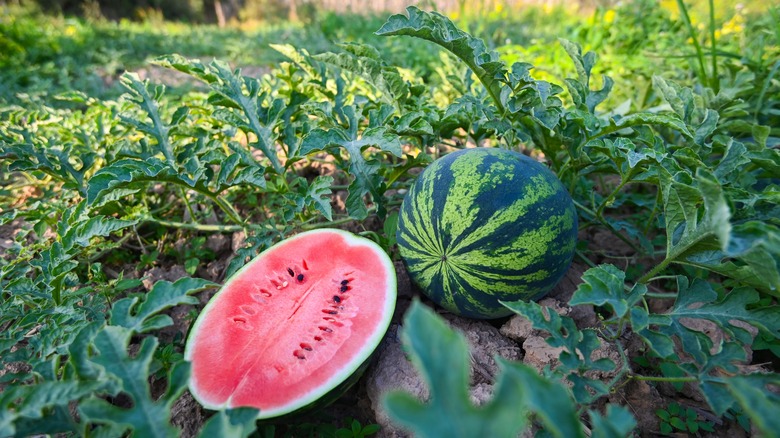Here's How Many Watermelons Per Plant You Can Expect In The Right Conditions
Watermelons can be time- and labor-intensive crops, so you may want to know what kind of yield to expect so you can ensure your hard work pays off. Unfortunately, as with many things in gardening, the answer is: It depends. A single watermelon plant can yield two to four melons per season on average, but many factors can impact watermelon yield, including the types of watermelons you're growing, the length of your growing season, how much space they have, and your specific soil, water, and temperature conditions.
There are many watermelon cultivars available to grow, from the petite bush sugar baby melon, which seldom weighs over 12 pounds, to varieties like the massive Carolina cross, which can weigh in at a whopping 200 pounds. Generally speaking, larger watermelons take longer to mature, with the Carolina cross taking around 130 days, as opposed to the bush sugar baby's more manageable 80 days to maturity. If you want to grow watermelon in a chilly climate, and you have an especially short summer, be sure to pick a variety that can mature within your limited growing season or you may be left without any watermelon harvest at all. It is also worth considering that even for growers with a long enough season to allow large melon cultivars to reach maturity, these plants generally produce fewer fruits than miniature melons. If your only goal is to grow the most watermelons possible, smaller varieties are almost always your best bet.
Provide your watermelons enough space for a good yield
Watermelons are notorious space hogs in the garden, with one plant often requiring 20 square feet of growing space. While it may be possible to give the plants less space, overcrowding will likely result in a smaller harvest, both in terms of the size of the melons and their numbers.
If you're determined to grow watermelons despite limited space, one option is to grow vertically. As watermelons are vines, they are just as happy growing up a trellis or fence as they are sprawling along the ground. Whether you opt to DIY a strong garden trellis with items you already own or buy one from a store, make sure your trellis is sturdy and secure because even small watermelon varieties can weigh several pounds or more. If you opt to save garden space by growing your melons vertically you may also need to provide the fruits with some extra support to keep them from falling or damaging the vine. One good option is to put pantyhose over the watermelons when they are still young and secure the stockings to the trellis. The pantyhose will act as a sling to support the melons as they grow and mature.
The impact of soil, nutrients, and water on watermelon yield
While you may want to get your watermelon seeds or transplants in the ground as soon as possible, watermelons are heat-loving plants and are not at all frost-tolerant. Not only should you wait until after your last frost date to plant your watermelons, but it's best to wait until the soil temperature is at least 60 degrees Fahrenheit. Watermelons grow best with full sun and well-draining, fertile soil with plenty of compost. Your melons may fail to thrive if these conditions aren't met. You should be fertilizing most melons regularly. The Clemson Cooperative Extension recommends you prepare the bed with a 5-10-10 fertilizer before planting and then add more nitrogen-heavy fertilizers during the growing season.
Watermelons are also famously thirsty plants and grow best when they receive 1 to 2 inches of water every 2 weeks or so. Not enough water can lead to crop failure, but unfortunately, so can too much water, as vines and fruit can end up rotting. Timing is also important when watering your watermelons. To prevent fruits from splitting and to improve their flavor, it's best to provide less water during the final few weeks before harvest.


